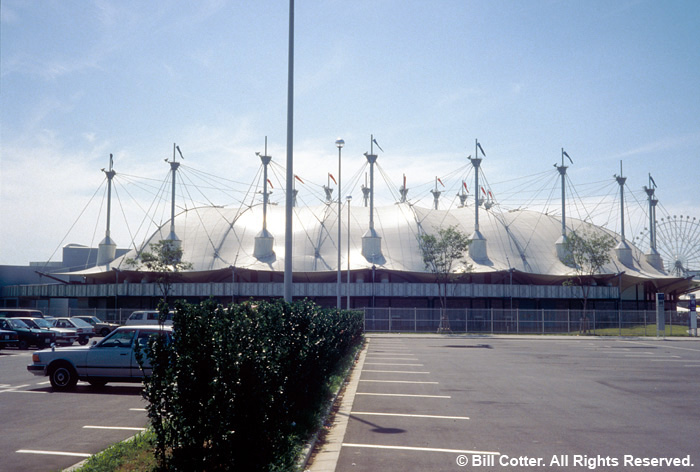United States of America
"Artificial Intelligence: Amplifying the Mind”
The pavilion consists of three structures – the Theme Pavilion, a theater, and the Corporate Pavilion. At the entrance is a 10-tiered, 6-m-high “light fountain”, created from larger-than-life-size “electronic components”.
The Theme Pavilion focuses on a field of research that could affect the world as profoundly as the Industrial Revolution – artificial Intelligence (AI) – the attempt to harness machines to mental tasks and create a machine that thinks. Clear, lively displays introduce the concept of AI, define the scope of the task of replicating human intelligence, and demonstrate the present state of the art.
THE ROAD TO ARTIFICIAL INTELLIGENCE A survey of computer development, from vacuum tubes to transistors, from the first integrated circuit (IC) to very large-scale integrated circuits (VLSI), microcomputers, and new hardware designed for AI applications.
NETWORKING A comparison of natural and synthetic networks, with parallels between the transistor and neuron, the computer and brain, and input-output devices and the nervous system's sensory and motor functions. A life-size model of TRW's TDRS communication satellite, the largest ever launched, hangs above the area to symbolize the importance of space communications.
FREE FLOW OF INFORMATION A display of the interdependence of a network's elements, with a computer terminal and printer to show the variety of information available from American data bases.
133 NOBEL LAUREATES A touch-sensitive monitor gives access to the lives and work of the 133 American Nobel Prize winners in the field of science.
REASONING WORKSHOP A demonstration of the enormous capabilities of the human mind, even that of a small child. Young visitors will enjoy the seven carefully designed games.
MIND MACHINE An AI system of the future, with video monitors, satellite dishes, robot arms, microphones, keyboards, etc., demonstrates processes such as memory access, deduction, inference, logic, and learning, in order to solve problems.
SYSTEMS DEMONSTRATION AREA See AI systems at work. Symbolics Inc. LISP machines diagnose illnesses, compose music, translate, create original art, and much more.
After the Theme Pavilion, you see an exhibition of works by American computer-graphic artists. In the theater, a 12-minute 70-mm film on the future of AI, called "To Think," will be playing continuously. The Corporate Pavilion, across from the theater, houses individual exhibits by DuPont, Polaroid, Texas Instruments, and TRW, as well as a restaurant and gift shop.

Seen from the parking lot outside A Block, this view of the United States Pavilion shows the system used to suspend the roof over the Theme Pavilion section. To me it looked like a circus tent. (CD #1 Set 1 #16)

Inside the Theme Pavilion visitors were treated to displays of the latest advances in computer technology from American industry. (CD #4 Set 8 #18)
I found the USA pavilion to be very disappointing. Following the failure of the 1984 New Orleans World's Fair the United States enacted a law prohibiting the use of federal funds at future expositions. As a result money had to be raised from corporations and private donors in order for the USA to have any presence at Expo '85. Instead of anything about the many benefits of American life, or the vast natural wonders, or many other possible themes, we were treated to what looked like trade show displays from Texas Instruments and Coca-Cola, the two largest sponsors. I don't begrudge the companies wanting to advertise their products, but I couldn't recall the very successful "soft sell" approaches used by Pepsi-Cola and Johnson Wax, among others,at the 1964-1965 New York World's Fair.
